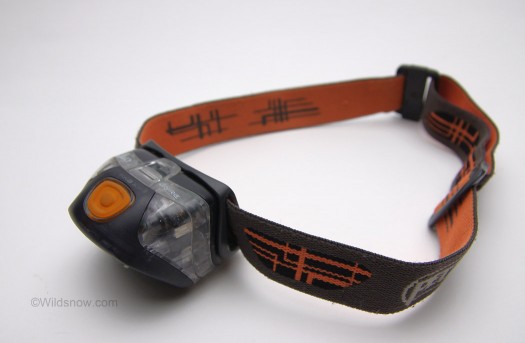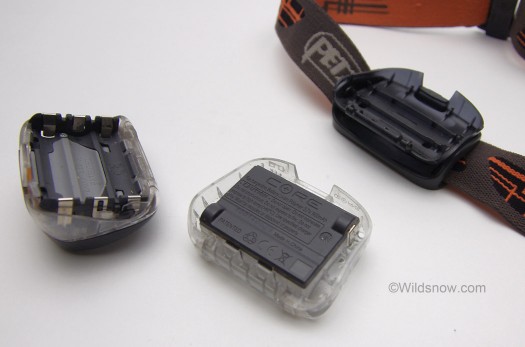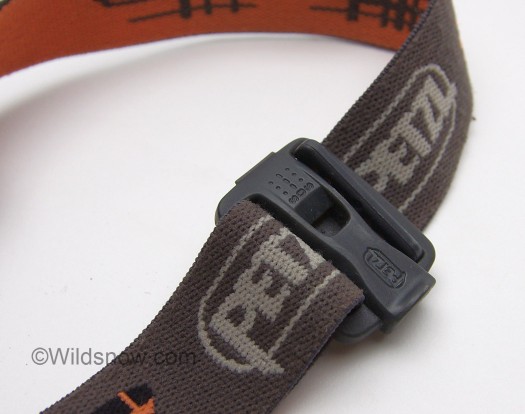After lacking a headlamp while losing the race with night at least once, it’s been my opinion that a lamp is one of the most important pieces of gear you can carry. On a dark night it’s tough to do anything without a good source of light.
On most days in the backcountry, especially long ones, I carry two headlamps, a bright, fairly large one, and a tiny backup. The big one sees a lot of use, and when not in use it bangs around around in my rucksack. Consequently I’ve gone through quite a few headlamps, ranging from cheap Wal-mart varieties to giant flamethrowers. Through the process of loss and destruction I like to think I’ve figured out what works well in a torch, and what doesn’t (for me, anyways).
Currently I’m using a Petzl Tikka CORE XP. It’s a mid-size headlamp, based on Petzl’s popular Tikka, with added features. I like headlamps of this size the best. They aren’t too small to provide enough light to ski by, and they aren’t too big or have an external battery pack, keeping the weight down. It also has the option of running on AAA batteries (more on that later), the same as most other electronic stuff I usually carry (beacon, Spot, etc). The Tikka has two brightness settings, a flashing mode, and a small red bulb. It also features a plastic diffuser that can be slid in front of the bulb in order to switch from spotlight to floodlight modes.
One of the coolest and definitely most unique features of the CORE XP is the battery system. It seems the most frequent headlamp malfunctions have to do with the owners forgetting to replace the batteries. Included with the headlamp is a small rechargable lithium ion battery pack that fits where one would normally place three triple A’s. The battery pack can be charged with a micro USB plug. Of course this doesn’t obviate the problem of your batteries running out. However, it does let you top off the electricity whenever you have the chance, eliminating the game of guess-that-charge. If the rechargeable battery runs out, you can simply take it out and replace it with three AAA’s. If every device with a proprietary battery had the same feature, it would save a lot of headaches. By periodically charging the CORE, I’ve been able to avoid buying an army of batteries, saving money (although probably not enough to offset the cost of the lamp).
Another interesting but slightly less useful consequence of the battery pack is the ability to plug it in to your computer and adjust the headlamp settings. Petzl’s included computer program mainly lets you adjust the brightness of various settings, and choose whether the LED is “regulated” or not. The regulated setting keeps the LED burning at almost full brightness until the last bit of juice is squeezed out of the batteries, then it quickly shuts off. This can be a little startling when it finally does suddenly turn off, but it’s nice to not have a dim headlamp for the last hours of the battery’s life, as with a normal LED.
I set the Tikka brightest setting to be as bright as possible, useful for navigating and skiing in the dark (as well as blinding ski partners). The maximum 40 lumens setting is indeed retina scorching although it does burn through the batteries fairly quickly. For the low setting, I set the LED to be almost as dim as it can get, maximizing battery life. This custom “ultra low” setting is great for most headlamp tasks, and the battery really does last for ages. I rarely, if ever, use the red light or the flashing light modes. Mysteriously, I’ve never seen the flashing mode used by anyone, and yet it is included on every headlamp I’ve owned, even the five dollar Wal-mart versions.
The diffuser lens can be flipped in front of the normal spotlight lens, creating a softer, more even light. Unlike lights that use separate bulbs for the flood setting, the full brilliance is retained. I usually keep the Tikka on the spot mode for everything but reading. A small, loud whistle is located on the headlamp strap as well. I’ve never used it, but its nice to have since I usually don’t carry one in my survival kit, thus ensuring my gear fulfills the “10 essentials.”
Most people don’t think of a headlamp as essential survival gear, but it is. Underestimations and the lure of one more powder lap have kept me out past dark many a time. The margin between a dangerous epic and a good time can be decided by a good light.
Shop for that Tikka CORE Headlamp
Louie Dawson earned his Bachelor Degree in Industrial Design from Western Washington University in 2014. When he’s not skiing Mount Baker or somewhere equally as snowy, he’s thinking about new products to make ski mountaineering more fun and safe.




